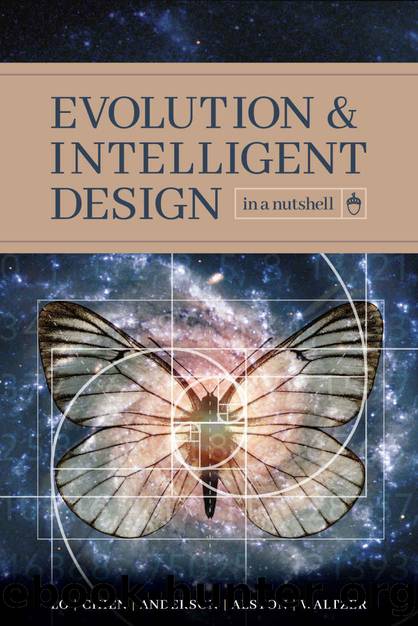Evolution and Intelligent Design in a Nutshell by Thomas Lo & Paul Chien & Eric Anderson & Robert Alston & Robert Waltzer

Author:Thomas Lo & Paul Chien & Eric Anderson & Robert Alston & Robert Waltzer [Lo, Thomas]
Language: eng
Format: azw3, epub
Publisher: Discovery Institute
Published: 2020-05-18T16:00:00+00:00
Figure 4.2. Drawings of Galápagos finches. Short, stout beaks better allow for eating hard seeds. Long beaks better allow for digging in tree bark to catch insects and other small organisms.
Entomologist Yuri Philiptschenko is said to have coined the German form of the terms “microevolution” and “macroevolution” in a 1927 German work.5 The influential Russian-American evolutionary biologist Theodosius Dobzhansky introduced the terminology into English in his 1937 work Genetics and the Origins of Species. There he commented that “we are compelled at the present level of knowledge reluctantly to put a sign of equality between the mechanisms of macro- and microevolution.”6
Why reluctantly? Because as Dobzhansky conceded, while we can directly observe and construct experiments that produce microevolution, we have not been able to observe or produce macroevolution. Even today when we attempt it, more than eighty years after Dobzhansky wrote those words, we continue to hit a microevolutionary wall, and quite early. We see this even in the case of microbes that reproduce rapidly and in enormous populations, where millions of mutations and tens of thousands of generations are possible.
So what “compelled” Dobzhansky to equate micro- and macroevolution? It seems that it was his commitment to the existence of macroevolution combined with the confessed lack of direct observational support for macroevolution. That is, he wanted to demonstrate that the entire diversity of life required no mechanisms beyond those of micro-evolution, but he couldn’t observe or produce macroevolution in order to clinch the case, so he settled for demonstrating microevolution and then equating it with macroevolution.
Dobzhansky and other evolutionary theorists are, of course, free to equate the two, but the rest of us are free to note the crucial difference, the very inequality that Dobzhansky himself noted. Indeed, reason urges us to do so. Acknowledging the crucial difference, the inequality, is key to clear thinking on the issue.
Can unguided microevolutionary changes accumulate and lead to dramatic macroevolutionary changes? Can they, for instance, lead to the rise of the first ocean-going animals, or the first dinosaurs, or the first mammals? Can they produce sonar in bats? We cannot even rationally address the question until we first acknowledge the clear difference between microevolution and macroevolution.
Equivocation Alert
EQUIVOCATION is the logical fallacy of changing the meaning of a word in the middle of an argument. Take, for example, the following argument: “Whenever it’s sunny out, the streets are dry. Harriet has a sunny disposition. Therefore, whenever Harriet is out, the streets are dry.” The word “sunny” in the first place means the sun is shining; in the second place it means upbeat and cheerful.
Arguments defending evolution often resort to equivocation, trading on the fact that the term evolution can refer to several different things. Take, for instance, someone who says that evolution is a fact, where by “evolution” he means the idea that natural selection working on accidental genetic mutations has produced macroevolution, the evolution of new structures and forms in the history of life. Suppose that this person then tries to prove evolution in
Download
Evolution and Intelligent Design in a Nutshell by Thomas Lo & Paul Chien & Eric Anderson & Robert Alston & Robert Waltzer.epub
This site does not store any files on its server. We only index and link to content provided by other sites. Please contact the content providers to delete copyright contents if any and email us, we'll remove relevant links or contents immediately.
Sapiens: A Brief History of Humankind by Yuval Noah Harari(14322)
Sapiens by Yuval Noah Harari(5325)
Pale Blue Dot by Carl Sagan(4960)
Homo Deus: A Brief History of Tomorrow by Yuval Noah Harari(4873)
Livewired by David Eagleman(3730)
Origin Story: A Big History of Everything by David Christian(3666)
Brief Answers to the Big Questions by Stephen Hawking(3394)
Inferior by Angela Saini(3294)
Origin Story by David Christian(3170)
Signature in the Cell: DNA and the Evidence for Intelligent Design by Stephen C. Meyer(3103)
The Gene: An Intimate History by Siddhartha Mukherjee(3075)
The Evolution of Beauty by Richard O. Prum(2966)
Aliens by Jim Al-Khalili(2804)
How The Mind Works by Steven Pinker(2782)
A Short History of Nearly Everything by Bryson Bill(2666)
Sex at Dawn: The Prehistoric Origins of Modern Sexuality by Ryan Christopher(2500)
From Bacteria to Bach and Back by Daniel C. Dennett(2462)
Endless Forms Most Beautiful by Sean B. Carroll(2446)
Who We Are and How We Got Here by David Reich(2418)
